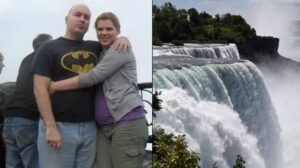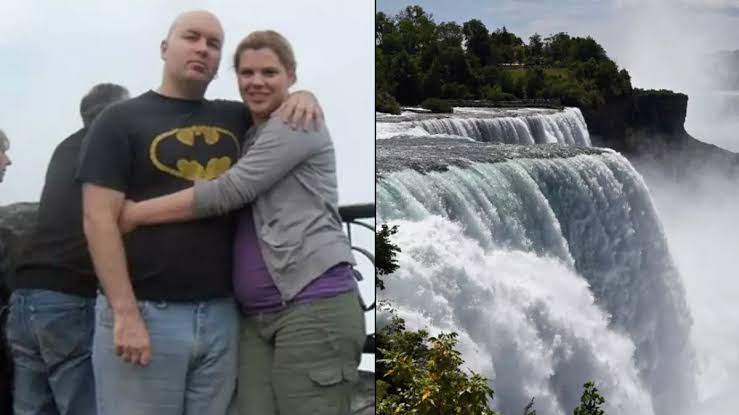One Dead, One Missing After Couple Swept Away at Niagara Falls
Tragic Love Story: One Dead, One Missing After Couple Swept Away at Niagara Falls
Niagara Falls, Ontario – September 1992
A romantic getaway ended in heartbreak and tragedy when a young couple was swept into the violent waters of the Niagara River during a sudden storm surge in September 1992. Despite rescue efforts, only one body was recovered, while the other remains missing to this day.

The incident occurred on the Canadian side of Niagara Falls, not far from the edge of the mighty Horseshoe Falls. The couple, later identified as 26-year-old Michael Barrett and 24-year-old Rachel Linwood, both from Ottawa, had been visiting the falls to celebrate their third anniversary together. What was meant to be a weekend of love and celebration quickly turned into a nightmare as nature unleashed its fury.
Ignoring the Warning Signs
According to park officials and eyewitnesses, the Niagara region was already under a storm advisory earlier in the day. Heavy rains had begun to fall steadily by mid-afternoon, causing water levels in the Niagara River to rise. Rapid runoff from upstream rainfall and increased flow from hydroelectric stations led to dangerous surges in the upper river—conditions that authorities warned could lead to flash flooding near the rapids.
Park rangers had posted temporary warning signs and barriers along the viewing areas closest to the river. Yet several visitors continued to approach the water’s edge, hoping to snap dramatic photos or catch a closer glimpse of the raging current.
Among them were Michael and Rachel.
“They looked happy,” said one witness, an American tourist who asked to remain anonymous. “She was taking pictures of the river, and he was pointing something out. But then the rain really started coming down hard, and the river looked wild.”
Swept Away in Seconds
The couple had made their way past a rope barrier to a rocky outcrop near the rapids, an area often off-limits during poor weather. The surface, already slick from rain, became treacherous as runoff water poured across the rocks.
Witnesses described the moment with horror.
“There was a loud splash, and I saw the woman go down first,” said James McDougall, a nearby visitor. “The man tried to grab her, but the current took him too.”
Both were pulled violently into the river. Onlookers screamed for help while a park ranger radioed for emergency assistance. Rescue boats and helicopters were dispatched, but visibility and conditions made the search nearly impossible.
Later that evening, Michael’s body was recovered nearly a kilometer downstream, battered against the rocks near the base of the falls. Rachel’s body was never found.
A Love Remembered
The couple had been dating since college and were widely regarded by friends and family as inseparable. Michael, an engineer, and Rachel, a freelance illustrator, shared a love for travel, photography, and adventure. Their joint social media accounts were filled with images from hiking trips, camping excursions, and weekend escapes across Canada.
“This is absolutely devastating,” said Rachel’s sister, Emily Linwood. “They were soulmates. They had just talked about getting married next summer. It’s hard to believe this really happened.”
Friends organized a candlelight vigil at Parliament Hill in Ottawa days after the accident. Photos of the couple, letters, and flowers were placed beneath a memorial tree, while mourners shared memories of their kindness, creativity, and unbreakable bond.
A Wake-Up Call for Tourists
The tragic loss of Michael and Rachel reignited calls for stricter safety measures at tourist areas around the falls, especially during stormy conditions.
Niagara Parks officials admitted that while signs and temporary barriers had been in place, they may not have been enough to deter determined visitors.
“We do everything we can to keep people safe,” said one ranger. “But ultimately, we can’t stop everyone from taking risks. This incident is a heartbreaking reminder of how quickly things can go wrong.”
The incident also led to a public awareness campaign urging visitors to respect safety warnings and barriers, particularly during severe weather. Multilingual signage, added barriers, and increased ranger patrols were implemented in the years that followed.
Nature’s Power and Unpredictability
Experts remind the public that Niagara Falls, while stunning, remains a powerful and dangerous natural force. The Niagara River’s flow can surge dramatically during storms, and the rapids just upstream of the falls can sweep away even the strongest swimmers in seconds.
“People often underestimate how quickly things can turn,” said Dr. Allan Greene, a hydrologist at the University of Toronto. “The river’s force increases exponentially during a surge. When you’re standing near the edge, one wrong step is all it takes.”
Dr. Greene also warned that climate change may be contributing to more erratic weather patterns in the region, with sudden downpours and extreme conditions becoming more frequent.
A Mystery That Still Haunts
Rachel Linwood’s body was never recovered, despite extensive search efforts along the river, at the base of the falls, and downstream toward Lake Ontario. Her family held a memorial service a week later, hoping for closure.
“We keep hoping for a miracle,” her mother, Judith Linwood, said at the time. “But we also know the river doesn’t give up everyone it takes.”
Even decades later, the story of Michael and Rachel continues to be told by tour guides and rangers as a cautionary tale—one that underlines the importance of caution, respect for nature, and heeding official warnings.
In Memory
A small plaque was later placed near the spot where the couple was last seen, engraved with the words:
“In memory of Michael Barrett and Rachel Linwood—Forever in love, forever in the falls.”
To this day, visitors leave flowers at the site.






